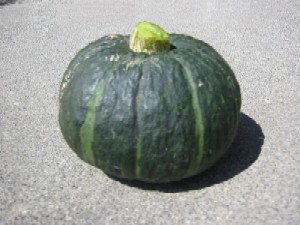- Kabocha
Taxobox
name = Kabocha

image_width = 240px
regnum =Plant ae
divisio = Magnoliophyta
classis =Magnoliopsida
ordo =Violales
familia =Cucurbitaceae
genus = "Cucurbita "
species = "Cucurbita maxima "
subdivision_ranks = Subspecies
subdivision = See textKabocha (katakana: カボチャ) is a Japanese variety of
winter squash . The word "kabocha" has come to mean a general type of winter squash to many English-speaking growers and buyers.Kabocha is commonly called Japanese
pumpkin , especially inAustralia ,New Zealand andSoutheast Asia , and kabocha squash inNorth America . In Japan, the word "kabocha" may refer to either the squash discussed in this article or to the Western-stylepumpkin .Varieties include: Ajihei, Ajehei No. 107, Ajihei No. 331, Ajihei No. 335, Cutie, Ebisu, Emiguri, and Miyako.
Today many of the kabocha in the market are of the type called Kuri kabocha, which was created based on Seiyo kabocha (buttercup squash). It's popular for its strong yet sweet flavor and moist, fluffy texture, which is like chestnuts. It's found in the market under such brand names as Miyako, Ebisu, Kurokawa, Akazukin, etc.
Characteristics
Kabocha is hard, has knobbly-looking skin, shaped like a squatty pumpkin, and has a dull colored deep green skin with some celadon-to white-colored stripes, and an intense yellow-orange color on the inside. In many respects it is similar to the
Buttercup squash , but without the characteristic cup on the blossom end. It is a member of the species "Cucurbita maxima", along with the Hubbard and Buttercup squashes.An average kabocha weighs 2-3 pounds, but can weigh as much as 8 pounds. [ [http://www.epicurious.com/tools/fooddictionary/entry?id=3123 kabocha squash Definition in the Food Dictionary at Epicurious.com] ]
It has an exceptional naturally sweet flavor, even sweeter than
butternut squash . It is similar in texture and flavor to apumpkin and asweet potato combined. Some can taste like aRusset potato . Like other squash-family members, it is commonly mixed in side dishes and soups, or anywhere pumpkin, potato, or other squash would be. It is a common ingredient in vegetabletempura and makes a wonderful soup by adding a small amount of rice or wheat starch.Kabocha is available all year round, but is best in late summer and early fall.
Primarily grown in
Japan ,California ,Florida ,Tasmania ,Hawke's Bay New Zealand ,Southwestern Colorado ,Mexico ,Chile , andSouth Africa , but is widely adapted for climates that provide a growing season of 100 days or more. Most of the California, Colorado and New Zealand crop is exported to Japan.Nutrition
It is rich in
beta carotene , withiron ,vitamin C ,potassium , and smaller traces ofcalcium ,folic acid , and minute amounts ofB vitamins . [ [http://japanesefood.about.com/od/vegetable/p/japanesekabocha.htm Japanese Kabocha - Japanese Pumpkin - Kabocha Squash] ,About.com ]Ripening
When kabocha is just harvested, it is still growing. So, unlike other vegetables and fruits, freshness isn't as important. It should be fully matured first, in order to become flavorful. First, kabocha is ripened in a warm place (77°F) for 13 days, during which some of the starch converts to carbohydrate content. Then it's transferred to a cool place (50°F) and stored for about a month in order to increase its carbohydrate content. In this way the just-harvested, dry, bland-tasting kabocha is transformed into smooth, sweet kabocha. Fully ripened, succulent kabocha will have reddish-yellow flesh and a hard skin with a dry, corky stem. It is heavier than it looks. It reaches the peak of ripeness about 1.5~3 months after it's harvested.
History
It is generally believed that all squash originated in
Mesoamerica .Fact|date=February 2008 The kabocha, however, was introduced to Japan by Portuguese sailors in 1541, who brought it with them fromCambodia . The Portuguese name for the pumpkin, "Cambodia abóbora" (カンボジャ・アボボラ), was shortened by the Japanese to kabocha. Certain regions of Japan use an alternate abbreviation, shortening the second half of the name instead to "bobora". Another name for kabocha is 南瓜 or 南京瓜 (Nanking melon), which suggest that the vegetable arrived in Japan by way ofChina .According to a different source, the squash was grown in North America in the past two decades and almost the entire crop was imported to Japan. [http://www.vegparadise.com/highestperch10.html Vegetarians in Paradise/Kabocha History, Kabocha Nutrition...] ] Approximately 10-15% of the crop is made available for American consumers.
References
Wikimedia Foundation. 2010.
